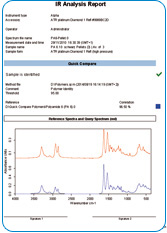
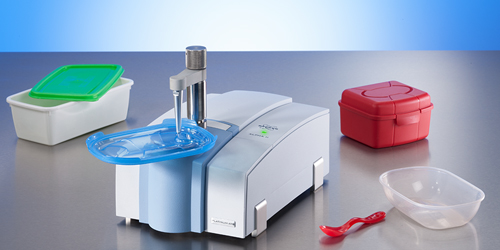
Plastics are used in countless products such as automotive parts, packaging materials, home appliance, electric devices or textiles. Many of today’s plastics are complex multi component systems made from various compounds like different polymers, fillers and additives. The systematic selection and blending of these constituents in appropriate mixtures results in materials with optimized properties.
As a high product quality at low price is a basic requirement in modern industry, reliable quality control is mandatory. An essential step for a trouble-free manufacturing process without waste is to verify the correct identity of the incoming raw materials. Later on the correct composition in the final plastic product has to be checked to ensure the right properties.
Using the ALPHA II a quick and reliable check of the correct chemical composition of the product is performed.
Identity verification of incoming raw materials:
To verify the correct identity of an incoming material an IR-spectrum is measured and compared against spectra from reference materials. A high correlation of the sample spectrum with the reference spectrum of the same material confirms the correct identity.
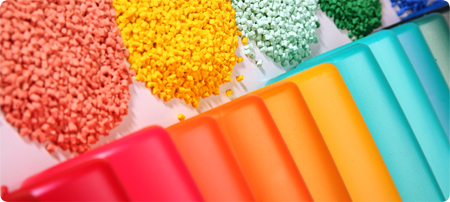
| Read application note about IR spectroscopic identity verification of polymer samples. |  |
| Read application note about identification of o-rings / (dark) rubbers. |  |
Differentiation of polyamides:
Polyamides are thermoplastic polymers consisting of monomers joined by an amide bond. The polyamide group
includes many different polymers with different chemical and physical properties. Despite a high similarity in their chemical structure IR spectroscopy allows to differentiate between various polyamides like PA6, PA6.6, PA10 and PA12.
Differentiation of HDPE and LDPE:
Polyethylene (PE) is the most produced polymer in the world. High density PE is used for bottles, boxes whereas plastic films and bags are made from low density PE. The IR-spectrum contains information that allows the differentiation of low density and high density PE.
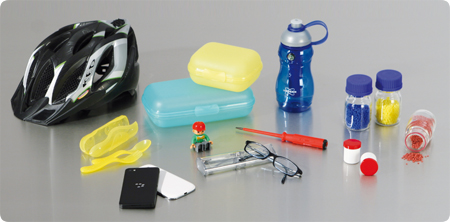
| Read application note about IR spectroscopic differentiation of polyamides. |  |
Quantification of fillers, additives and blends:
Modern plastics are multi component systems made from polymers, fillers, plasticizers and compatibilizers. To determine the correct composition is an essential part of the quality control. The IR-spectrum allows to quantify individual components on base of calibrations.
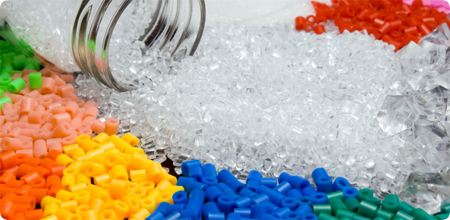
| Read application note about IR spectroscopic analysis of polymer fillers and compatibilizers. |  |
Control of the curing of varnish:
The material properties of modern paints and varnishes are critically influenced by the curing process.
FT-IR spectroscopy quickly and reliably allows to measure the degree of cure of paints, varnishes and the like.
Within only a minute a quantitative conclusion about the curing state of the sample can be drawn.
Control of coatings on metallic materials:
Polymeric coatings are used to protect surfaces of metals, ceramics and other materials from corrosion. Furthermore the properties of surfaces can be defined by appropriate coatings, e.g. roughness, visual appearance, adhesiveness.
IR-analysis allows to control the presence of the correct coating material on various substrates. Furthermore the homogeneity of the coating can be determined.

| Read application note about the control of the degree of vanish curing. |  |
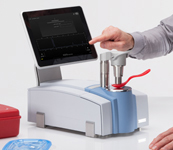 The measurement interface of the ALPHA II for polymer analysis is a diamond ATR crystal. Its mechanical and chemical robustness allows as well the analysis of reactive liquid samples like monomers as of very hard plastics like polycarbonate. The ATR (Attenuated Total Reflection) technique is very comfortable and fast as there is virtually no sample preparation required. No matter if the analysis has to be performed on pellets, films, plastic parts, powders or liquids: For recording the IR-spectrum the sample just has to be brought into contact with the ATR crystal.
The measurement interface of the ALPHA II for polymer analysis is a diamond ATR crystal. Its mechanical and chemical robustness allows as well the analysis of reactive liquid samples like monomers as of very hard plastics like polycarbonate. The ATR (Attenuated Total Reflection) technique is very comfortable and fast as there is virtually no sample preparation required. No matter if the analysis has to be performed on pellets, films, plastic parts, powders or liquids: For recording the IR-spectrum the sample just has to be brought into contact with the ATR crystal.
After the measurement the sample is identified by automatic comparison of its spectrum against spectral data from reference materials.
click to enlarge 